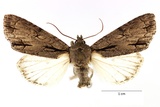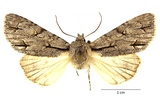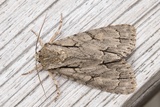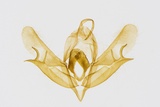Acronicta tridens ([Denis & Schiffermüller], 1775) Species
Last modified: Nov. 17, 2025, 7:21 p.m.
A not so common species throughout Belgium.
Data Deficient due to a lack of sufficient data according to the IUCN Red List category for Flanders 2023.
Details
- Classification
- Family: Noctuidae > Subfamily: Acronictinae > Genus: Acronicta > Subgenus: Triaena > Species: Acronicta tridens
- Vernacular names
- Drietand (NL), Dark Dagger (EN), Le Trident (FR), Dreizack-Pfeileule (DE)
- First mention in Belgium
- De Sélys-Longchamps E. 1844. Énumération des insectes Lépidoptères de la Belgique. — Mémoires de la Société royale des Sciences de Liége 2: 1–35. On page 10 (as Acronycta tridens F.). view page
- Status
-
Native
Distribution
Imago
Wingspan 35–45 mm.
Adults of Acronicta cuspis, Acronicta tridens and Acronicta psi cannot be safely distinguished from each other, except by reference to the genitalia. Although larvae of these species are quite different and are easy to identify as species.
Caterpillar
From May till October.
Bionomics
The species hibernates, sometimes for several years as a pupa under bark or in bark crevices of the foodplant.
The adults come to light and sugar.
Flight periods
The adults fly in two generations a year from mid-April till the beginning of September.
Observed on
- Host plant (species):
- Prunus spinosa
- Host plant (genera):
- Crataegus, Quercus, Rosa, Salix and Cotoneaster
- Substrates:
- Deciduous trees and Shrubs
The larva lives on a range of trees and shrubs like Crataegus, Prunus spinosa, Salix, Quercus, Rosa, and Cotoneaster.







